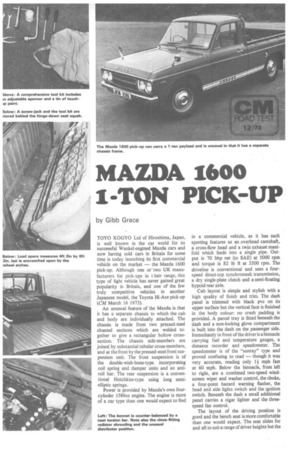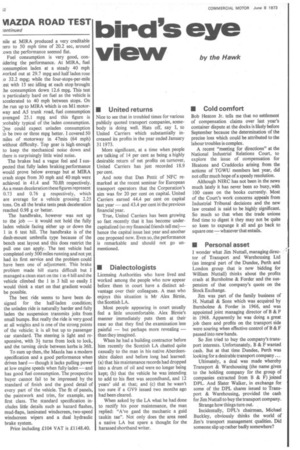MAZDA 1600 I-TON PICK-UP
Page 52

Page 53

Page 54

If you've noticed an error in this article please click here to report it so we can fix it.
by Gibb Grace TOY° KOGYO Ltd of Hiroshima, Japan, is well known in the car world for its successful Wankel-engined Mazda cars and now having sold cars in Britain for some time is today launching its first commercial vehicle on the market — the Mazda 1600 pick-up. Although one or twoUK manufacturers list pick-ups in t heir range, this type of light vehicle has never gained great popularity in Britain, and one of the few truly competitive vehicles in another Japanese model, the Toyota Hi-Ace pick-up (CM March 16 1973).
An unusual feature of the Mazda is that it has a separate chassis to which the cab and body are individually attached. The chassis is made from two pressed-steel channel sections which are welded together to give a rectangular hollow crosssection. The chassis side-members are joined by substantial tubular cross-members, and at the front by the pressed-steel front suspension unit. The front suspension is of the double-wish-bone-type incorporating coil spring and damper units and an antiroll bar. The rear suspension is a conventional Hotchkiss-type using long semielliptic springs.
Power is provided by Mazda's own fourcylinder 1586cc engine. The engine is more of a car type than one would expect to find
in a commercial vehicle, as it has such sporting features as an .overhead camshaft, a cross-flow head and a twin exhaust manifold which feeds into a single pipe. Output is 70 bhp net (to SAE) at 5000 rpm and torque is 82 lb ft at 3500 rpm. The driveline is conventional and uses a fourspeed direct-top synchromesh transmission, a dry single-plate clutch and a semi-floating hypoid rear axle.
Cab layout is simple and stylish with a high quality of finish and trim. The dash panel is trimmed with black pvc on its upper surface but the vertical face is finished in the body colour: no crash padding is provided. A parcel tray is fitted beneath the dash and a non-locking glove compartment is built into the dash on the passenger side. Immediately in front of the driver is a binnacle carrying fuel and temperature gauges, a distance recorder and speedometer. The speedometer is of the "sunray" type and proved confusing to read — though it was very accurate, reading only 11 mph fast at 60 mph. Below the binnacle, from left to right, are a combined two-speed windscreen wiper and washer control, the choke, a four-point hazard warning flasher, the head and side lights switch and the ignition switch. Beneath the dash a small additional panel carries a cigar lighter and the threespeed fan control.
The layout of the driving position is good and the bench seat is more comfortable than one would expect. The seat slides for and aft to suit a range of driver heights but the
squab angle is not adjustable. Headroom is very good considering that the seat is set higher than in a car. The seat-squab hinges forward to reveal storage space for a really workmanlike screw-jack and a tool kit. This kit is very comprehensive by today's standards and includes adjustable and openended spanners, plug spanner, screw-driver and a small tin of touch-up paint.
On the road
Unladen the Mazda handled just like a car, and handling remained good with a 1-ton load — but with rear tyre pressures at 60 psi and the front at 40 psi. The vehicle was handed over to us with diagonally opposite tyres at 60 psi and the others at 30 and 40 psi. In this condition it was not noticeably unstable unladen but had understandably bad handling when first loaded.
There is also a point which needs making here regarding the load. The payload used for the test was 30Ib steel weights and because of their density it was possible to get a 1-ton payload on the vehicle without overloading the rear axle but with a bulkier load this might be difficult because of the rear axle position, and the payload could thus be effectively reduced.
Fully laden the Mazda grossed over 2 tons and the best performance was achieved by making full use of the gears. The engine has plenty of power once over 3500 rpm but lacks torque low down, so although maximum acceleration runs on the level nile at MIRA produced a very creditable Eero to 50 mph time of 20.2 sec, around own the performance seemed flat.
Fuel consumption is very good, conidering the performance. At MIRA, fuel msumption laden at a steady 40 mph worked out at 29.7 mpg and half laden rose 32.2 mpg; while the four-stops-per-mile est with 15 sec idling at each stop brought :he consumption down 12.6 mpg. This test .5 particularly hard on fuel as the vehicle is accelerated to 40 mph between stops. On he run up to MIRA which is on MI motorway and AS trunk road, fuel consumption averaged 25.1 mpg and this figure is )robably typical of the laden consumption. Dne could expect unladen consumption to be two or three mpg better. I covered 50 miles of motorway in 47min (64 mph) without difficulty. Top gear is high enough to keep the mechanical noise down and there is surprisingly little wind noise.
The brakes had a vague feel and I suspected that fully laden braking performance would prove below average but at MIRA crash stops from 30 mph and 40 mph were achieved in 41.4 and 70.8ft respectively. As a mean deceleration these figures represent 0.73 and 0.76 g respectively, which are average for a vehicle grossing 2.25 tons. On all the brake tests peak deceleration reached 0.98 g or better.
The handbrake, however was not up to the job — it would not hold the fully laden vehicle facing either up or down the 1 in 6 test hill. The handbrake is of the dash-mount umbrella type because of the bench seat layout and this does restrict the pull one can apply. The test vehicle had completed only 500 miles running and not yet had its first service and the problem could have been one of adjustment. This brake problem made hill starts difficult but I managed a clean start on the 1 in 4 hill and the vehicle climbed the 1 in 3 hill so easily I would think a start on that gradient would be possible.
The best ride seems to have been designed for the half-laden condition; the unladen ride is naturally harder and fully laden the suspension transmits jolts from small bumps. But really the ride is very good at all weights and is one of the strong points of the vehicle; it is all but up to passenger car standard. The steering is light and responsive, with 3+ turns from lock to lock, and the turning circle between kerbs is 36ft.
To sum up then, the Mazda has a modern specification and a good performance when driven hard — though it lacks pulling power at low engine speeds when fully laden — and has good fuel consumption. The prospective buyer cannot fail to be impressed by the standard of finish and the good detail of every part of the vehicle. The fit of panels, the paintwork and trim, for example, are first class. The standard specification includes little details such as hazard flashes, mud-flaps, laminated windscreen, two-speed windscreen wipers and a dual hydraulic brake system.
Price including £104 VAT is £1148.40.












































































































































